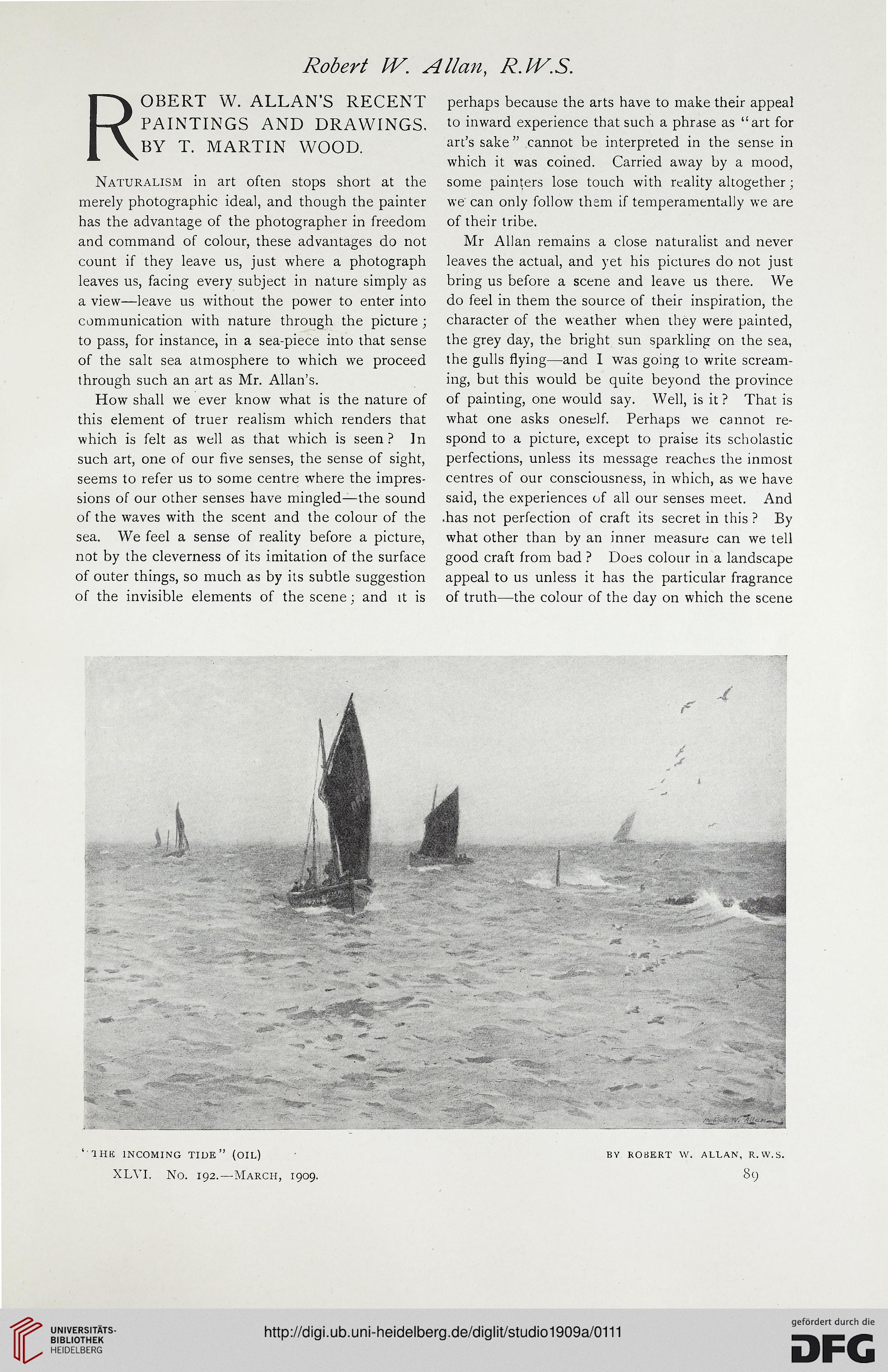Robert IV. Allan, R.IV.S.
Robert w. Allan's recent
PAINTINGS AND DRAWINGS.
BY T. MARTIN WOOD.
Naturalism in art often stops short at the
merely photographic ideal, and though the painter
has the advantage of the photographer in freedom
and command of colour, these advantages do not
count if they leave us, just where a photograph
leaves us, facing every subject in nature simply as
a view—leave us without the power to enter into
communication with nature through the picture ;
to pass, for instance, in a sea-piece into that sense
of the salt sea atmosphere to which we proceed
through such an art as Mr. Allan’s.
How shall we ever know what is the nature of
this element of truer realism which renders that
which is felt as well as that which is seen? In
such art, one of our five senses, the sense of sight,
seems to refer us to some centre where the impres-
sions of our other senses have mingled—the sound
of the waves with the scent and the colour of the
sea. We feel a sense of reality before a picture,
not by the cleverness of its imitation of the surface
of outer things, so much as by its subtle suggestion
of the invisible elements of the scene; and it is
perhaps because the arts have to make their appeal
to inward experience that such a phrase as “art for
art’s sake ” cannot be interpreted in the sense in
which it was coined. Carried away by a mood,
some painters lose touch with reality altogether;
we can only follow them if temperamentally we are
of their tribe.
Mr Allan remains a close naturalist and never
leaves the actual, and yet his pictures do not just
bring us before a scene and leave us there. We
do feel in them the source of their inspiration, the
character of the weather when they were painted,
the grey day, the bright sun sparkling on the sea,
the gulls flying—and I was going to write scream-
ing, but this would be quite beyond the province
of painting, one would say. Well, is it ? That is
what one asks oneself. Perhaps we cannot re-
spond to a picture, except to praise its scholastic
perfections, unless its message reaches the inmost
centres of our consciousness, in which, as we have
said, the experiences of all our senses meet. And
.has not perfection of craft its secret in this ? By
what other than by an inner measure can we tell
good craft from bad ? Does colour in a landscape
appeal to us unless it has the particular fragrance
of truth—the colour of the day on which the scene
'imc incoming tide” (oil)
XLYI. No. 192.—March, 1909.
Robert w. Allan's recent
PAINTINGS AND DRAWINGS.
BY T. MARTIN WOOD.
Naturalism in art often stops short at the
merely photographic ideal, and though the painter
has the advantage of the photographer in freedom
and command of colour, these advantages do not
count if they leave us, just where a photograph
leaves us, facing every subject in nature simply as
a view—leave us without the power to enter into
communication with nature through the picture ;
to pass, for instance, in a sea-piece into that sense
of the salt sea atmosphere to which we proceed
through such an art as Mr. Allan’s.
How shall we ever know what is the nature of
this element of truer realism which renders that
which is felt as well as that which is seen? In
such art, one of our five senses, the sense of sight,
seems to refer us to some centre where the impres-
sions of our other senses have mingled—the sound
of the waves with the scent and the colour of the
sea. We feel a sense of reality before a picture,
not by the cleverness of its imitation of the surface
of outer things, so much as by its subtle suggestion
of the invisible elements of the scene; and it is
perhaps because the arts have to make their appeal
to inward experience that such a phrase as “art for
art’s sake ” cannot be interpreted in the sense in
which it was coined. Carried away by a mood,
some painters lose touch with reality altogether;
we can only follow them if temperamentally we are
of their tribe.
Mr Allan remains a close naturalist and never
leaves the actual, and yet his pictures do not just
bring us before a scene and leave us there. We
do feel in them the source of their inspiration, the
character of the weather when they were painted,
the grey day, the bright sun sparkling on the sea,
the gulls flying—and I was going to write scream-
ing, but this would be quite beyond the province
of painting, one would say. Well, is it ? That is
what one asks oneself. Perhaps we cannot re-
spond to a picture, except to praise its scholastic
perfections, unless its message reaches the inmost
centres of our consciousness, in which, as we have
said, the experiences of all our senses meet. And
.has not perfection of craft its secret in this ? By
what other than by an inner measure can we tell
good craft from bad ? Does colour in a landscape
appeal to us unless it has the particular fragrance
of truth—the colour of the day on which the scene
'imc incoming tide” (oil)
XLYI. No. 192.—March, 1909.





